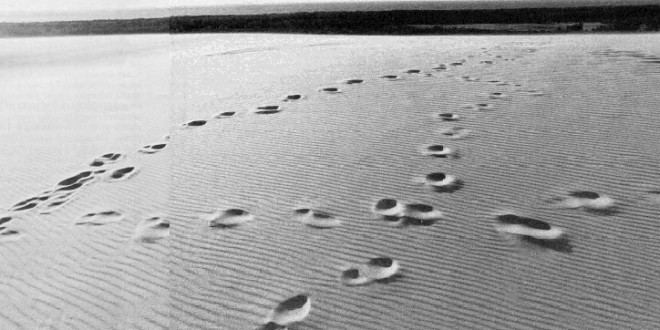BY JOE LUKAITIS.
IT IS TOLD that a long, long time ago, Karvaitis, ruler of the Island of Užmaris in the Baltic Sea, had a giant daughter named Neringa. Neringa was very beautiful and very good to people. She would try to help them in any way she could. During storms, she would step into the sea and by grabbing fishing boats by their anchors, would bring them to the safety of the shore. At other times, she would show the way to travellers who might become lost in the dense woods. She did many other good deeds.
One day, Bangputis, God of the Sea, became angry at the mortals and lashed a terrible storm against them. The storm raged for several years, covering the Lithuanian seacoast with tons of sand and dust, and flooding fields, farms and entire villages. It even threatened to destroy the coastal castle of Vente.
Neringa was saddened by the hardship of the people, and decided to protect them from Bangputis’ anger. She filled her apron with sand, and stepping into the sea began pouring sand into the water. Wherever she poured, sand dunes formed. She kept pouring until a long, narrow strip of land began to form in the middle of the sea. This strip of sand blocked the fury of the wind and waves and protected the coastal towns. It also created a smaller body of water on the other side which offered protection to the fishermen’s boats. From that time on, people started calling this strip of sandy land, Neringa.
Well, that’s only a legend. But the beauty of Lithuania is not legendary. Although Lithuania does not distinguish itself by soaring mountain peaks, roaring waterfalls or steamy rain forests, its gently rolling hills, sparkling lakes, colorful castles, and particularly its amber-colored Baltic coastline, are real!
The most outstanding feature of this coastline is of course the Courish Spit, a narrow sandy peninsula separating the Courish Lagoon (Kuršiu Marios) from the Baltic Sea. In Lithuanian this body of land has been known by various names: Kuršiu Nerija, Neringa (Nehrung in German) and Užmaris (“Beyond the Sea”).
The bow-shaped Spit, running in a northeasterly direction, is about 6l miles long, but only two and a half miles at its widest part. In some places is as narrow as half a mile. The larger northern part of the Spit belongs to Lithuania. The southern part belonged to Germany until 1945. After 1945 it has been under Russian administration as part of the Kaliningrad region. Upon occupying it, the Russians changed all the ancient Baltic place-names.
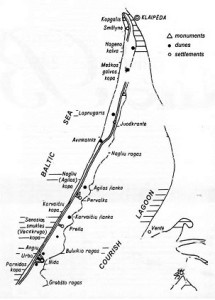
Origin
By earth’s standards, the Courish Spit is a very young creation. It came into existence some 5,000 years ago in place of a chain of small islands in the Baltic, and owes its existence to the sea and the winds. Sand from the bottom of the sea accumulated between the islands and formed the barrier which kept growing and changing, and still keeps changing to this day. Trees, bushes and grasses began growing right from the start, and eventually covered the entire peninsula.
Sand dunes
The thing that makes the Courish Spit so unique, not only in Lithuania but in the entire world, are the spectacular sand dunes, called “kopos” in Lithuanian. They are considered to be the largest and tallest seashore dunes in the world. The dunes extend for miles and miles along the Spit and can reach heights of 185 feet or more. They are the result of wind blowing sand from the bottom of the Baltic Sea and depositing it on the western banks of the Spit. This same wind blows the sand across the top of the dunes from where it slides down onto the eastMAP: ern shore and into the Courish Lagoon. Because of this phenomena the dunes are known by various names: moving, drifting, travelling or wandering dunes.
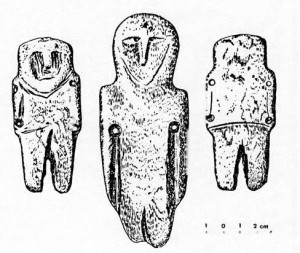
Attempts to control the dunes
As soon as man began populating the Spit, destruction of the original forests began. This deforestation intensified during the 15th century. By the 18th century, almost the entire Spit had become bare, resembling a pile of sand and dust. This desolation was not only an ecological disaster, but a serious threat to human habitation as well. Entire villages ended up buried by the drifting sand. As soon as the population of a village moved to another location, it would be buried again. Scores of settlements of various sizes lie buried under the sand up to this day.
In order to cope with the desperate situation, a number of projects were proposed during the 18th century. It was decided that reforestation would be the only solution. But the project did not get a start until a single man, Jurgis Dovydas Kuveitas, a postal worker from the town of Nida, took the initiative and single-handed planted thousands of pines, birches and other trees. The forest he planted survives to this day. The grateful residents of Nida erected a monument in his honor on his father’s grave. The monument bears the inscription: “His son, Jurgis Dovydas Kuveitas, was the first to plant trees in the joyless dessert of Nida”. From this time on, the Prussian government undertook the task of reforestation of the Spit. Today, about two thirds of the Spit is covered with vegetation and the other third is made up of bare dunes.
The drifting sands are still a threat to the Spit’s villages, the Courish Lagoon and the nearby port of Klaipėda. Barricades and all sorts of obstacles had been built since the beginning of the 19th century. In addition to trees, various types of bushes and grasses were also planted to stop the destructive force of the dunes.
But the dunes are the greatest attraction of this area. Some are so huge and widespread that the landscape they provide gives one the impression of being in the middle of the Sahara Desert. Some of the dunes are famous for either their height or their shape. Some of the most famous are: the wood-covered Urbas, with an old beacon on its top, the tree-capped Angis, the white-sand Parnidis, and the Gliders’ Dune, which was used by a gliding school which functioned here in the past.

Flora and Fauna
The present vegetation of the Spit is varied, although most of it is not indigenous to the area since it was introduced by man. It is distinguished by a variety of pines, including mountain pines brought from Western Europe. Other trees include oaks, birches, maples. Hardy grasses of many types grow on the dunes and along the coasts. The forested areas offer refuge to many animals. There is the moose or European elk, which is Europe’s largest wild animal and which has lived on the Spit since ancient times. There are also deer, wild boars, foxes and hares, as well as sea eagles, cormorants and grey herons. About 15 million birds rest here during the spring and fall migrations. In Rasyte, on the southern part of the Spit, the first bird tracking station in the world was established in 1901.
History and Settlement
Human habitation on the Courish Spit began at the end of the Mesolithic period (ca. 3,500 B.C.). It seems to have been quite densely populated during the Neolithic period (ca. 3,5001,800 B.C.) since a large number of settlements from that period have been uncovered. Tools made of stone, bone and wood found in these settlements indicate that the early inhabitants engaged in fishing, hunting and agriculture. A large hoard of artistic amber was found near the town of Juodkrante, indicating the inhabitants’ high artistic skills and their attachment to amber, which was plentiful in the area. Finds from the Bronze and Iron ages show that up to historical times (9th-13th cenairies), the Spit was populated by Balts (Lithuanians and Prussians). Large burial sites from the 13th- 15th centuries have also been found. They show that people were buried in wooden coffins and not cremated. The corpses wore ornaments of copper, glass and amber.
Beginning with the 8th century, Northmen or Vikings, which the Lithuanians called “žuvedai” (“Fish eaters”), began raiding the Lithuanian shores. To escape these raids, people moved further inland. By the 10th century, the Viking raids subsided, and settlements began to grow again.
The Teutonic Knights occupied this region in the 13th century. They called it Neria. The road from Prussia to Livonia went through the Spit. Later it became an important postal route between Koenigsberg and Klaipėda.
A number of settlements were founded on the Spit, mostly along the eastern shore facing the Courish Lagoon. Unfortunately many of the settlements, including the hamlets of Kairaiciai, Kuncai, Nagliai, Agila and several others, were buried under the moving sands. The inhabitants of the town of Nida, the largest on the Spit, had to move their town three times to its present location.
Until the end of the First World War the entire Spit belonged to Germany. When Lithuania regained the territory of Klaipėda in 1923, it also gained the northern part of the Spit.
One of the most famous residents of the Spit was Liudvikas Reza (17761840), a poet and prominent specialist of Lithuanian folklore, whose birthplace Kairaiciai was one of the 14 villages buried by the sand. Another prestigious resident was the famous German writer Thomas Mann (1875-1955), whose restored house stands in Nida today.
In I960 the Courish Spit was proclaimed a nature preserve, and in 1976 was designated a National Forest Park. It became a favorite spot with tourists. Every year one hundred thousand visitors from Lithuania and every corner of the former Soviet Union came here. Therefore a plan for the conservation of the Spit was adopted in 1967. Strict nature and environment protection regulations were introduced. Now the construction of buildings is very limited and the number of visitors is being controlled.
In 1961 the settlements of Juodkrante, Pervalka, Preila and Nida were joined into one administrative unit which was named Neringa. All administrative, community and cultural offices are located in Nida, the Spit’s largest settlement.
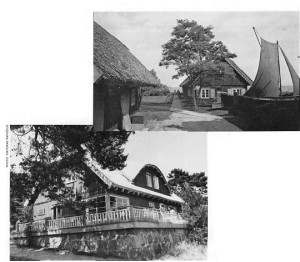
-Thomas Mann’s House has been restored and is now a museum.
Visiting the Courish Spit
One reaches the Courish Spit by a ferry, which takes you from the mainland port of Klaipėda to Smiltyne located at the northern tip of the peninsula. The ferry, which also carries automobiles, takes about half an hour to reach the Spit at the narrowest stretch of water separating it from the mainland. Once on the Spit, the only way to go is on a straight line southward, unless you want to make a small detour to visit the Maritime Museum located in Kopgailis, a little farther to the north.
You will be passing some of the most beautiful landscapes in the world: dense pine forests, where you might spot an elk or two grazing; beautiful green valleys; and heights from which you might be able to see two bodies of water (Baltic Sea and Courish Lagoon) at the same time.
You will also be passing a number of old settlements such as Juodkrante, Preila, Pervalka and Nida, where the new architecture reflects an ingenious application of local artistic heritage. Every settlement preserves its unique atmosphere and appearance, and has its own places of interest.
For example, the “Witches’ Hill” (Raganu kalnas) in the vicinity of Juodkrante is one site you should not miss. A winding path leads you to the top of the pine-covered mound, where every step of the way is covered with hundreds of huge carved wooden statues of witches, goblins, monsters and all sorts of characters from legends, myths and folk tales.
In addition to the house of Thomas Mann, Nida has other attractions such as the Fishermen’s Museum and other restored old houses, where the past and present history of Neringa, as well as the original ethnic culture of the Spit is told through various expositions. Noteworthy are the so called “krikštužiai” (ornamental figures carved from planks of wood and installed on graves) which are a peculiarity of this Lithuanian territory and can be admired in a cemetery nearby.
In order to better visualize what you would see if you decide to visit the Courish Spit on your next trip to Lithuania, let me allow Professor Vytautas Gudelis to give you his impressions: “The Spit reminds us of a scythe with its cutting edge directed against the attacking Baltic. Its east shore is broken by numerous bays and capes called “ragas” in Lithuanian. The most picturesque of the capes is Grobstas. The capes are made up of drifting sand blown by the wind from the dunes right into the Courish Lagoon.
The lan d scape of the Spit shows distinct longitudinal zones. Along the seashore, which constitutes a fine sandy beach, run beach-dunes, for the most part man-made and tended by human hand.
East of the beach-dunes stretches a level plain covered with grass, shrubbery and forests, called “palve” in Lithuanian. After crossing the “palve” one gets into a belt of sand hillocks beyond which rises a huge wall of dazzling white shifting dunes. For nearly 44 miles the dune mountains extend, fantastically beautiful, strange beyond description because they are so totally unexpected, so completely different from the familiar landscape. All along the shore the dunes run close to the Lagoon, their bluff slopes rising sheer out of the water. Most of the wandering dunes have been anchored with the help of strong-growing plants and pine-trees, while the rest belongs still to the realm of drifting sands.
But the Courish Spit does not mean dunes only. It is a strongly fascinating kaleidoscope of landscapes, where land and sea, lagoon and forest meet and melt into one; of changing colors and sweeping clouds; of shimmering haze over the blue-green distances; of wonderful sunsets, unforgettable in pattern and hue; of marvelous mornings, fresh and dewy with the scent of pine and sea mingling with the subtle fragrance of copse and mossy earth”.
The late Dr. Ceslovas Kudaba, professor of Geography at Vilnius University once stated: “On the Courish Spit, as perhaps nowhere else in the world, a peculiar feeling of complete closeness to nature can be experienced. Here the variety and brightness of colors – the blueness of the sea and the sky, the whiteness of the sand dunes, the greenness of forests – is really striking. The Spit, created by nature and man, is a special place – once seen, its beauty will be never forgotten”. How true!
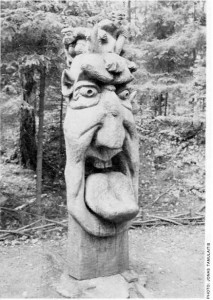
 DRAUGAS NEWS Lithuanian World Wide News in English
DRAUGAS NEWS Lithuanian World Wide News in English
